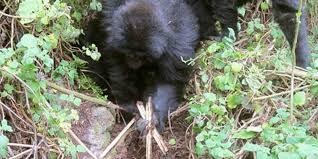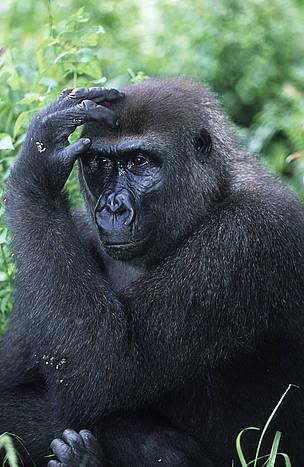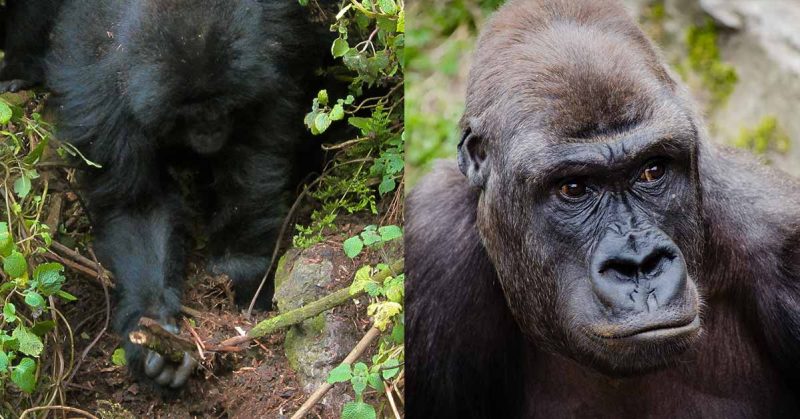In what is probably going to be a revolution in the animal kingdom, gorillas have somehow figured out how to dismantle traps set by poachers.
Gorillas–1, Poachers–0
Two 4-year-old mountain gorillas, Rwema and Dukore, male and female respectively, dismantled the traps set by poachers. The incident occurred at the Volcanoes National Park in Rwanda. The pair was caught on camera dismantling snares set by poachers.
The incredible moment was first witnessed by some conservationists from the Karisoke center who were combing the forest for traps to dismantle.
John Ndayambaje, a tracker, found a snare very close to the Kuryama gorilla clan. He attempted to deactivate it but was stopped by the grunts of Vubu, a silverback gorilla. That was when Rwema and Dukore sprang into action. They ran towards the trap and as Rwema jumped on the bent tree branch, Dukore freed the noose.
The gorillas spotted another snare and went over to it when a third gorilla joined in and help them dismantle it. [1]
This behavior in the gorillas was set off after a tragic incident occurred
A week before their heroic act, a juvenile gorilla, Ngwino, was the unfortunate victim of a hunter’s snare in the forest. She got caught in the trap but was not able to break loose. Instead, she dislocated her shoulder and had deep rope cuts on her leg. The cuts led to gangrene — death of tissue — on her legs, which led to her tragic demise. She was discovered a bit too late by the workers from Karisoke.
It also didn’t help that the hunters had set the traps for antelopes and didn’t seem interested in the gorillas. Thus, they most likely left her and others caught in their traps to die. [2]
This was probably not their first time
While that was the first time anyone has ever seen gorillas do something of that nature, it seemed like the gorillas were used to it already.
According to Veronica Vecellio, Gorilla Program Coordinator at the Dian Fossey Gorilla Fund’s Karisoke Research Center, “This is absolutely the first time that we’ve seen juveniles doing that… I don’t know of any other reports in the world of juveniles destroying snares.”
“We are the largest database and observer of wild gorillas… so I would be very surprised if somebody else has seen that,” she added. [3]
Adult gorillas, especially silverbacks in the other group have occasionally been caught in the snares, and that was perhaps why the two juveniles were wary of the snares or aware of the dangers they pose.
The speed in which they used in dismantling the traps made Vecellio think that wasn’t their first time. “They were very confident. They saw what they had to do, they did it, and then they left,” she said.

This story shouldn’t come as a surprise
This incident doesn’t come as a surprise to some people including Vecellio. She admitted she wasn’t surprised by the story but is “always amazed and very proud when we can confirm that they are smart.”
Mike Cranfield, Veterinarian and the Executive Director of the Mountain Gorilla Veterinary Project, also said he was not shocked at all by the news. He figured they must have learned how to destroy the traps by watching the center’s trackers work.
He also discussed how chimpanzees are not the only resourceful primates. “Chimpanzees are always quoted as being the tool users, but I think when the situation provides itself, gorillas are quite ingenious,” he said.
If you’re wondering why people can’t just teach more gorillas how to free themselves from snares, here’s why: According to Vecellio, this is a no-no. “No, we can’t teach them. We try as much as we can to not interfere with the gorillas. We don’t want to affect their natural behavior.” [4]
The poacher’s snare
Poachers don’t necessarily walk around the forest with high-powered rifles shooting at random. Indeed, they track animals and shoot them down, but a more convenient method for them is the use of snares.
Snares are trapping devices, typically consisting of a noose, made of wire or cable. A snare is a long piece of wire with a loop at the end attached to a tree or log. The wire loop is then suspended from a branch so that the snare can catch an animal by its neck as it walks along the trail.
Once an animal is caught in a snare, struggling will only worsen the situation because as it continues to move forward the snare pulls tighter around its neck. These wire or cable snares are among the most deadly poaching tools out there. They cause the animals to die a cruel and agonizing death. [5]

A snare set up between two small trees
Why snares?
Snares are a favorite of hunters and, in that same vein, are detested by conservationists for basically the same reasons.
- Snares are difficult to find so conservationists have a hard time finding and dismantling them.
- They are easy to design. This makes them a favorite of hunters as they put in minimal effort in building them.
- Numerous snares can be set up at once. Due to their easy design, hunters can make as much as possible, making it more difficult for conservationists to get to all of them. Also, this means that sometimes the hunters aren’t able to keep track of all of them leading to the slow torturous death of the animals caught in it.
- They can catch any type of animal depending on the size of the animal and the snare, which is a plus for the hunters. [6]
Why are the gorillas able to dismantle snares?
Most times, these snares are set for antelopes and other bushmeat. Gorillas just end up in them accidentally. It also doesn’t help that the snares don’t care what animal that is, they just “ensnare” them.
However, gorillas, especially the adults, can break free because of their hands. A gorilla’s hands and wrists are very strong and stable. An adult gorilla’s upper body strength is six times stronger than an adult human. This makes them to be able to break and squeeze heavy objects.
Also, their thumbs and big toes oppose the other digits (fingers and toes). This feature enables them to be able to grasp and manipulate objects with their hands and feet.

Conservation status of gorillas and the threats to them
Gorillas are classified as an endangered species. The mountain gorilla, in particular, is regarded as being critically endangered. Threats to their numbers include human-induced habitat loss and deforestation, their susceptibility to disease, hunting for their meat, poaching for private collections and sale of body parts, pet trade, accidental poaching, and lack of awareness. [7]

Despite the grim news on these great apes, there is hope yet for them. They seem to be rising to defend themselves if their escape and dismantling of snares is anything to go by. We hope to protect these creatures and get them off of the endangered list.
References
- “Gorillas Seen Dismantling Deadly Poacher Traps.” ABC News. Bazi Kanani. July 25, 2012.
- “Young Gorillas Have Learnt to Dismantle Poachers’ Traps in The Wild.” Science Alert. BEC CREW. March 26,2018.
- “In a remarkable first, researchers saw gorillas dismantle poacher traps.” Business Insider. Admin. January 28, 2016.
- “Gorilla Youngsters Seen Dismantling Poachers’ Traps — A First.” National Geographic. Ker Than. July 18, 2012.
- Young Gorillas Seen Dismantling Poachers’ Traps For First Time.” Yahoo News. Rob Waugh. January 29, 2016.
- “Young Gorillas in Rwanda Have Learned to Work Together to Dismantle Poachers’ Traps.” Second Nexus. Robin Evans. May 30,2018.
- “Endangered Mountain Gorilla Populations Are Growing.” Smithsonian. Brigit Katz. December 17, 2019.

